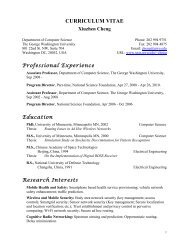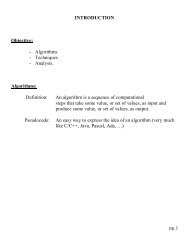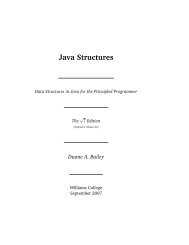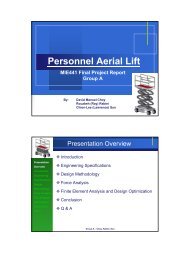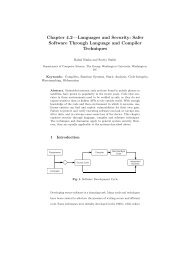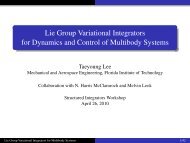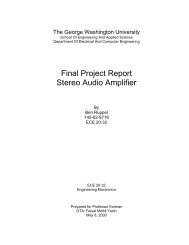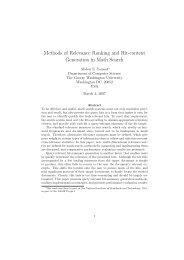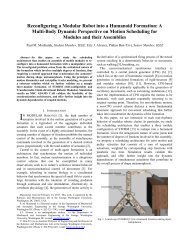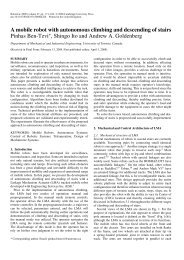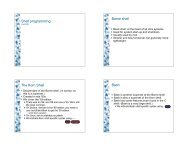Design and Analysis of a Hybrid Mobile Robot Mechanism ... - SEAS
Design and Analysis of a Hybrid Mobile Robot Mechanism ... - SEAS
Design and Analysis of a Hybrid Mobile Robot Mechanism ... - SEAS
Create successful ePaper yourself
Turn your PDF publications into a flip-book with our unique Google optimized e-Paper software.
as specified in Table 2. The control angle in C2 provides speed<br />
variability to each <strong>of</strong> Links 2 <strong>and</strong> 3 when simultaneously operated.<br />
Fig. 12 „a… Control Stick No. 1 „C1… motion layout; „b… Control<br />
Stick No. 2 „C2… motion layout<br />
larly, an up <strong>and</strong> down movement <strong>of</strong> the second control stick will<br />
generate an independent CW <strong>and</strong> CW motion <strong>of</strong> Link 3, respectively.<br />
Furthermore, four diagonal movements <strong>of</strong> the second control<br />
stick i.e., +x, −x, +y, −y directions as shown in Fig.<br />
12b will generate simultaneous motions <strong>of</strong> Links 2 <strong>and</strong> 3 as<br />
follows.<br />
i Movement <strong>of</strong> the control stick in the +x direction will<br />
simultaneously move both Links 2 <strong>and</strong> 3 in the CW direction.<br />
ii Movement <strong>of</strong> the control stick in the −x direction will<br />
simultaneously move both Links 2 <strong>and</strong> 3 in the CCW direction.<br />
iii Movement <strong>of</strong> the control stick in the +y direction will<br />
simultaneously move both Links 2 <strong>and</strong> 3 in the CW <strong>and</strong><br />
CCW directions, respectively.<br />
iv Movement <strong>of</strong> the control stick in the −y direction will<br />
simultaneously move both Links 2 <strong>and</strong> 3 in the CCW <strong>and</strong><br />
CW directions, respectively.<br />
The CW <strong>and</strong> CCW wrist motions <strong>of</strong> the gripper mechanism as<br />
well as the open <strong>and</strong> close motions <strong>of</strong> the gripper jaws are generated<br />
with a separate mode <strong>of</strong> the first control stick.<br />
The first <strong>and</strong> second control sticks can be simultaneously operated<br />
by the operator in order to provide simultaneous motions <strong>of</strong><br />
the tracks along with different motion combinations <strong>of</strong> Links 2<br />
<strong>and</strong> 3, as explained above.<br />
The above motion procedures are summarized in Fig. 12 <strong>and</strong><br />
Table 2. Figure 12a shows the top view <strong>of</strong> Control Stick No. 1<br />
C1 with two switchable states as follows: i track motions—<br />
State 1 S1; <strong>and</strong> ii gripper mechanism motions—State 2 S2.<br />
Figure 12b shows the top view <strong>of</strong> Control Stick No. 2 C2 with<br />
two coordinate systems x-y <strong>and</strong> x-y for Links 2 <strong>and</strong> 3 motions,<br />
Tracks<br />
motions<br />
Gripper<br />
Table 2<br />
<strong>Robot</strong> motion specifications<br />
FWD BWD Right Left<br />
C1+S1<br />
+y H/L<br />
Wrist<br />
CW<br />
C1+S2<br />
+y<br />
C1+S1<br />
−y H/L<br />
Wrist<br />
CCW<br />
C1+S2<br />
−y<br />
C1+S1<br />
+x H/L<br />
Gripper<br />
jaws<br />
open<br />
C1+S2<br />
+z<br />
C1+S1<br />
−x H/L<br />
Gripper<br />
jaws<br />
close<br />
C1+S2<br />
−z<br />
CW CCW CW/CCW CCW/CW<br />
Link 2 alone C2 +x C2 −x N/A N/A<br />
Link 3 alone C2 +y C2 +y N/A N/A<br />
Links 2+3 C2 +x C2 −x C2 +y C2 −y<br />
6 Modeling <strong>and</strong> Dynamic Simulations <strong>of</strong> the <strong>Hybrid</strong><br />
<strong>Robot</strong>ic System<br />
Dynamic simulations <strong>of</strong> the complete robotic system were performed<br />
in order to study its functionality <strong>and</strong> demonstrate its expected<br />
capability for design optimization purposes. The 3D mechanical<br />
design assembly that was developed with a CAD s<strong>of</strong>tware<br />
was exported to <strong>and</strong> modeled in ADAMS s<strong>of</strong>tware to perform motion<br />
simulations. The simulation experiments are accounting for<br />
the mass distribution <strong>of</strong> the robot including batteries, motors,<br />
electronics, etc., inertia properties <strong>and</strong> acceleration <strong>of</strong> the links,<br />
as well as contact <strong>and</strong> friction forces between the links <strong>and</strong> tracks<br />
<strong>and</strong> the ground.<br />
When designing a mechanical system such as this hybrid robot,<br />
it was required to underst<strong>and</strong> how various components interact as<br />
well as what forces those components generate during operation.<br />
We used ADAMS, commercial motion simulation s<strong>of</strong>tware, to analyze<br />
the behavior <strong>of</strong> the entire robotic mechanical system. It allowed<br />
us to test virtual prototypes <strong>and</strong> optimize designs for performance,<br />
without having to build <strong>and</strong> test several physical<br />
prototypes. This dramatically reduced our prototype development<br />
time <strong>and</strong> cost.<br />
The simulations enabled us to visualize <strong>and</strong> validate various<br />
robot mobility cases to study its functionality <strong>and</strong> hence optimize<br />
the design. The design optimization process involved weight distribution<br />
optimization, proper component selection e.g., springs<br />
for track tension/suspension, motors, <strong>and</strong> gear ratios, etc. Weight<br />
distribution optimization was performed by identifying the optimal<br />
weight <strong>of</strong> each robot link base links, Link 2, <strong>and</strong> Link 3<br />
such that the robot’s posture remained stable tip-over stability<br />
during the motion <strong>of</strong> the robot links while performing various<br />
locomotion <strong>and</strong> manipulation tasks. This was done by visualizing<br />
each task with the aid <strong>of</strong> the animations, as described in detail in<br />
Sec. 6.1, <strong>and</strong> changing the weight <strong>of</strong> each link as necessary until<br />
a stable posture was observed during the entire range <strong>of</strong> the link<br />
motion for a particular task. This procedure was repeated for several<br />
locomotion <strong>and</strong> manipulations tasks, as described in Secs. 6.1<br />
<strong>and</strong> 6.4, respectively, until a common optimal combination <strong>of</strong> link<br />
weights was identified. The requisite for a flexible dynamics capability<br />
for the track system was addressed with ADAMS tracked<br />
vehicle ATV toolkit. A modus oper<strong>and</strong>i using ADAMS <strong>and</strong> ATV<br />
toolkit was developed <strong>and</strong> used to model the tracks 52,53.<br />
The data pertaining to each simulation performed were processed<br />
for the following specific major purposes that will be discussed<br />
in detail in subsequent subsections: i study the robot’s<br />
mobility characteristics through animations <strong>of</strong> different possible<br />
tasks that require various locomotion <strong>and</strong> manipulation capabilities,<br />
ii analyze the suspension <strong>and</strong> track tension retention by<br />
examining the spring array force distributions, iii define each<br />
joint’s torque requirements for different mobility tasks <strong>and</strong> select<br />
proper gear ratios <strong>and</strong> motors, <strong>and</strong> iv define maximum endeffector<br />
payload capacity for different robot configurations. Different<br />
types <strong>of</strong> terrains such as flat roads, obstacles, stairs, ditches,<br />
<strong>and</strong> ramps were created in a manner such that they could be easily<br />
changed according to different size <strong>and</strong> shape requirements.<br />
6.1 Mobility Characteristics <strong>Analysis</strong>: Animation Results.<br />
To study the robot’s functionality, the following simulations were<br />
performed: various manipulation scenarios all three modes <strong>of</strong> operation<br />
as described in Sec. 4.2, r<strong>and</strong>om rotations <strong>of</strong> all links,<br />
traversing pipes <strong>of</strong> different diameters, climbing <strong>and</strong> descending<br />
rectangular obstacles with different link configurations, crossing<br />
ditches with different gap dimensions, climbing <strong>and</strong> descending<br />
stairs, flipping over due to a ramp obstacle, lifting tasks, <strong>and</strong><br />
more. To illustrate, few <strong>of</strong> the above mentioned animation results<br />
072302-8 / Vol. 130, JULY 2008 Transactions <strong>of</strong> the ASME<br />
Downloaded 13 Jun 2008 to 128.100.48.224. Redistribution subject to ASME license or copyright; see http://www.asme.org/terms/Terms_Use.cfm



